My friend Apostolos once asked me how I meet people at the Camino. How do I know if someone wants to talk or walk alone? How do I make the first connection? In my opinion it’s easy to make friends on the Camino. How do you start a conversation with strangers? You don’t need to overthink your first words, just try: “Buen Camino, how are you?” Ask people why they came. How’s their journey so far. Ask for help. Offer help. The rest will follow naturally.
People are interested in getting to know you, don’t miss the chance to get to know them too!
As an African proverb says: If you want to walk fast, walk alone. If you want to walk far, walk together.
How do pilgrims communicate with each other? Majority of them speak at least basic English, and of course it helps to know other languages. Online translators are a nice option too, but don’t count on mobile signal everywhere. In fact, communication on the Camino fascinates me and is one of the profound reasons why pilgrim routes feel like home for me. I, European citizen, Erasmus program veteran, remember how to say cheers in twenty languages and my favorite food from many countries. However, words are not always necessary to communicate. I’ve seen people falling in love with the help of Google translate, creating friendships based on smiles and expressing overwhelming care in a simple phrase „Are you OK?“. Silence is just another way of communication. You can silently walk beside someone for hours and still feel connected without knowing the person well. Maria and I shared our silences, laughter and pain. We walked half of the planned journey together, and now our paths were about to split.
We would also say goodbye to our Romanian friends. They would walk all the way to Vigo, while we planned to stop in A Ramallosa. I was the first to wake up in our beautiful house, so I boiled eggs for breakfast and lunch. Because of our late arrival yesterday and a lack of good sleep, I woke up tired and a bit cranky. Maria and I hit the road when the Romanians were still getting ready. I didn’t want to walk in the group and wait for everyone, but it was still ok for me to make adjustments for Maria. Luckily, she felt better in the morning and decided to walk this short 16 km stage with me. Maybe the painful blister treatment really helped!
To her own big surprise, Maria walked faster than before. We greeted Kathy and Diane on our way and continued at my regular pace. Soon we discovered a cute art shop with hand-made souvenirs. Maria bought a pink shell for her backpack, which gave her nice motivation to continue walking. I was still cranky and my backpack felt off since we started. Since there was no pastel de nata to quickly fix my mood, I decided to fix my backpack. Remember the rule, heavier stuff at the bottom… I didn’t do that in the morning; I packed too quickly. And yes, reshuffling the objects really made a difference.
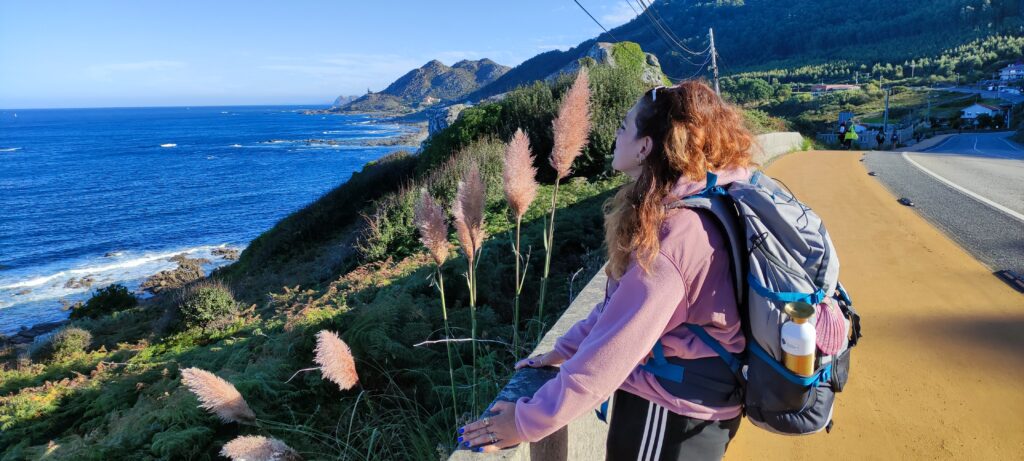
There was a small hill ahead, that we unanimously decided to skip following advice from our previous host. He described it as difficult and not interesting. We both preferred a flat detour along the coast. One hour later, a beautiful 4-star hotel with a sea view terrace seemed like a great spot for a break. There I finally consumed my orange juice and something sweet, and Maria had time to treat her blisters. Since the waiters in suits didn’t look down on us, smelly pilgrims, we assumed that other pilgrims stop here for a drink as well. Indeed, a random pilgrim who stayed overnight offered his blister advice to Maria. He also gifted her Compeed and Moleskin, something that she hadn’t tried yet. Everyone has their own method of dealing with blisters and Maria wanted to try them all.
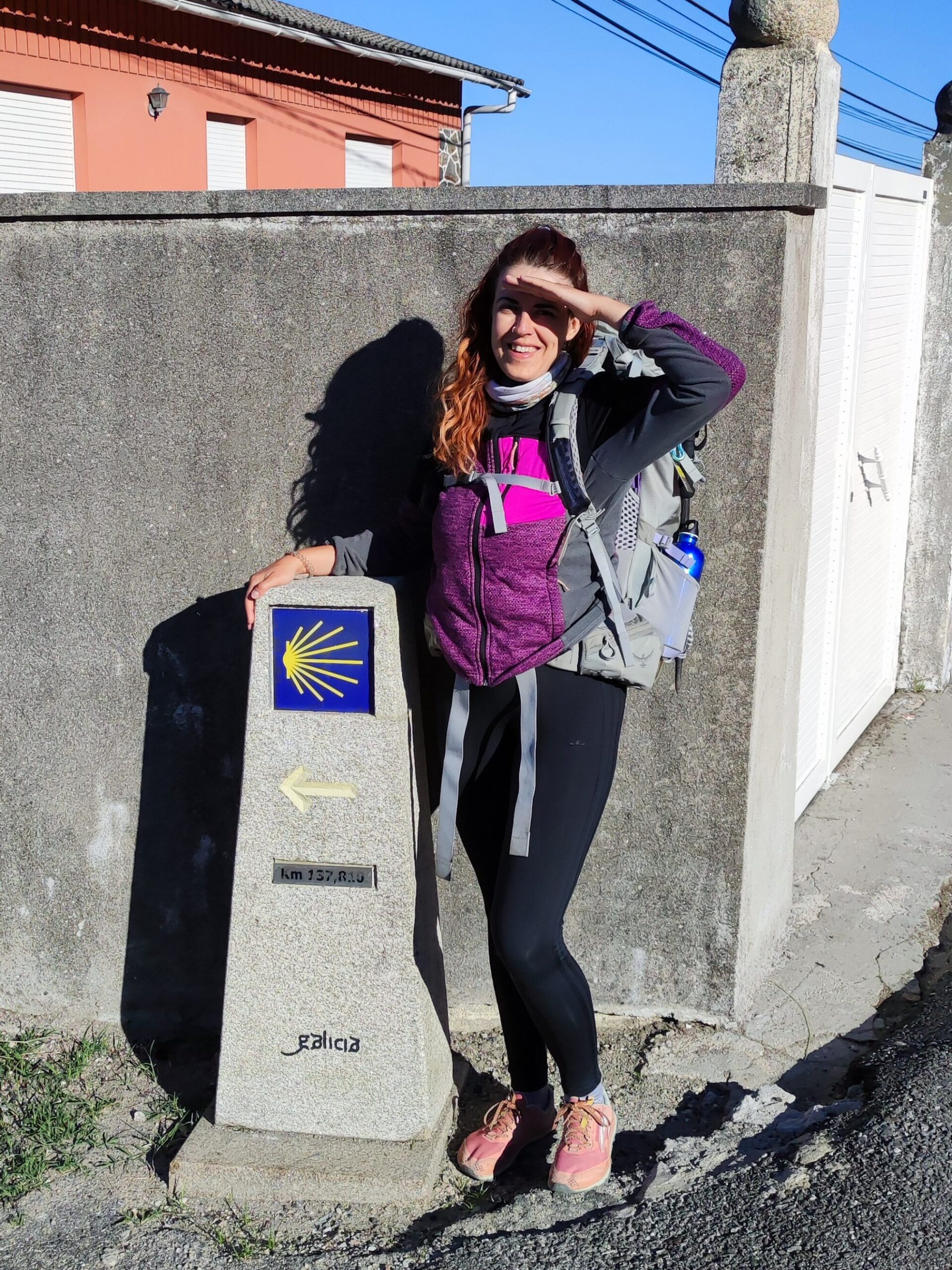
The following stop on our way was even more beautiful. A small cape welcomed us with a cozy lighthouse and a sea glass beach. Sea glass is created by polishing pieces of glass by water and rocks, for tens of years. I don’t know the story of this particular beach; I think Kathy mentioned a wrecked ship carrying glass bottles.
I’ve never had a chance to visit a sea glass beach before and it felt very surreal. We laid down, explored the colorful pieces and soaked up the sun.
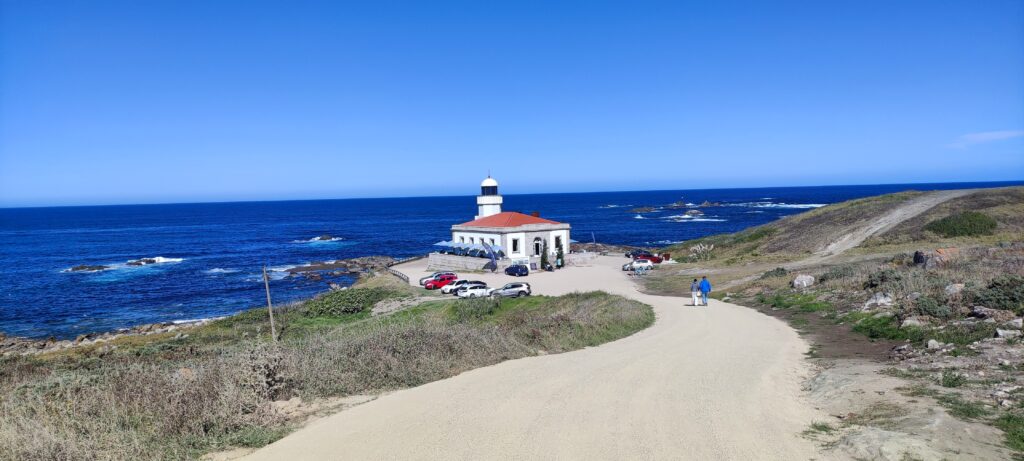
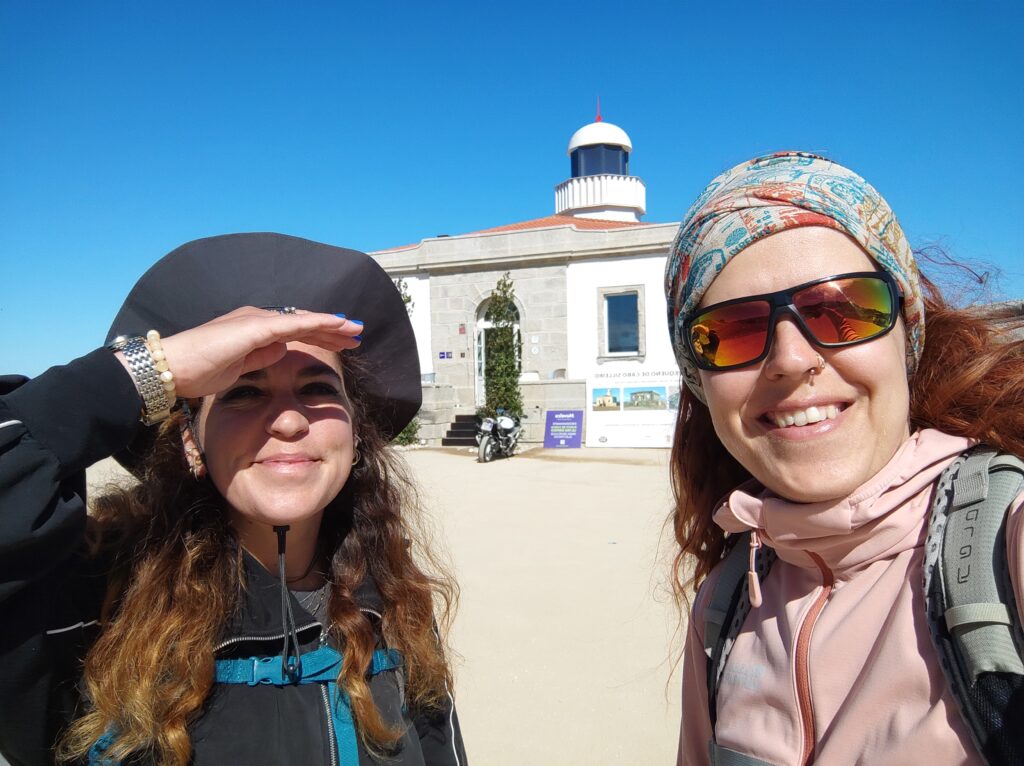
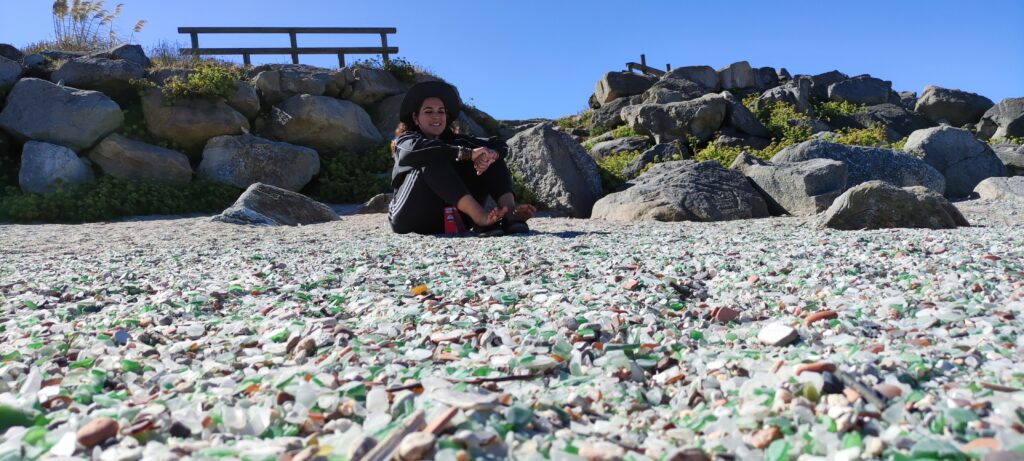
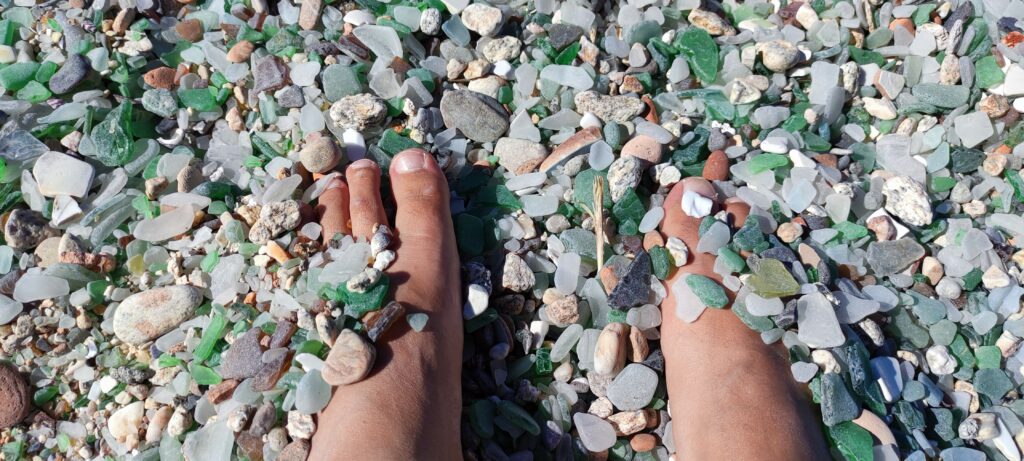
This was a perfect place for our meditation, just waves and sea breeze. Not many tourists around. Kathy and Diane arrived at some point. They walked through the hill this morning and got lost on the way. Well, I also felt a bit lost on that day. Thoughts of my future started creeping in and I didn’t feel ready yet. They came and disappeared in the breeze.
Maria was struggling with blister pain again and I suffered from heat of an asphalt road. We made it to Baiona in silence and guess who we found in a bar? Marian, Firita and Costel were drinking beer and hiding from the sun. This was our time to say goodbye. I was very thankful for meeting them and sharing adventures together. I wish I could understand Romanian and their unique humor.
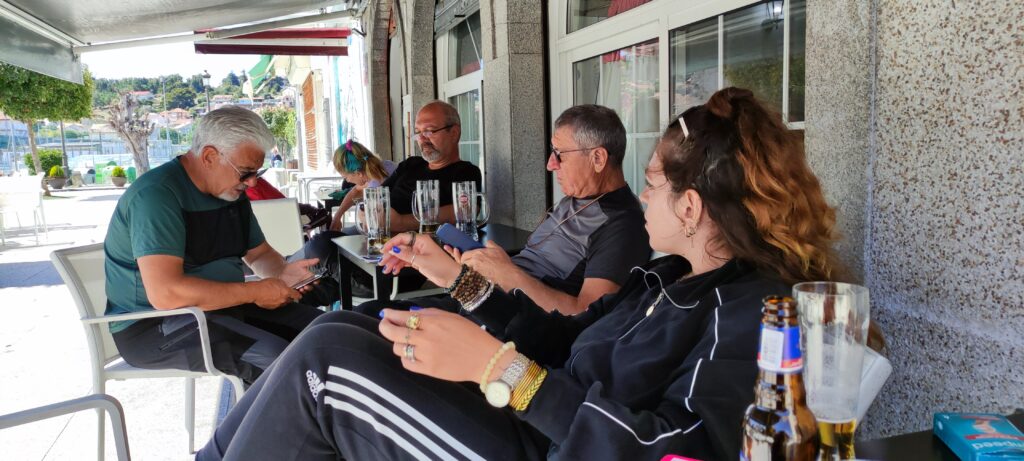
The afternoon sun heated up the air even more, so we continued walking with an ice cream in our hands. Maria barely made it, I was worried. Our albergue in A Ramallosa felt like a Ryanair plane – not enough space in any direction. I got annoyed and rather chilled with Maria outside. We found a hotel in Vigo. Not great, but not many options left, so we were relieved to get something. I spent good 45 minutes figuring out how to book a ticket to Cíes islands for my rest day. Since it’s a national park that limits the number of tourists, you first need to get a permit from the local government. Then you enter the permit code when booking a boat trip. September 15 was the last possible day for a visit, the end of season. I shared my experience and guidance with Kathy and she managed to book tickets for her and Diane as well.
Maria planned to take a bus on the next day. She could barely walk to a nearby pharmacy, and this was really the end of her suffering (hopefully). We had dinner together, reflecting on our journey so far. Right there, in a random bar on a village square, I rediscovered zamburiñas (Pecten maximus). This shell was established as a symbol of pilgrimage in the Middle ages. First of all, there happened to be many of them in Galicia. Second of all, it happened to be a practical lightweight bowl for food and drinks. Legends also say that St. James’ body arrived in Galicia covered in shells. I could give the shells more symbolic personal meaning, but this is not why I’m writing about them now.
Grilled scallop shells immediately claimed the leading position as my favorite seafood. And my pilgrim dinners would never be the same again.
I slept OK, but I was also eager to quickly leave our claustrophobic albergue. It was still dark outside when we sat down in front of a bakery with Maria. I was a bit overwhelmed by food options, so I stuck with my classic, croissants. Yesterday Maria asked a random woman for a lighter on our way to the albergue. Now the same woman sat next to us and somehow we started chatting. Alicia, from Tarragona, was doing her second Camino and guess what? She also planned to take a bus to Vigo and buy new shoes! They agreed to go shoe shopping together with Maria.
Alicia ordered a breakfast of champions – a huge piece of tortilla de patatas, pan con tomate, croissant, cola and café con leche. First thing she did was remove the mashed tomatoes from the bread. Then she pulled out her own tomato and a tiny bottle of olive oil from her bag. She skillfully rubbed the tomato into the bread and sprinkled it with oil.
Here you go, pan con tomate, polarizing Spanish society. Looking at this small woman, full of energy and pride, all I could say was “Que Viva España!”. She responded: “Por la comida, merece la pena. (It’s worth living here for the food)”.
Maria took a bus to Vigo and I started my first walk alone. When I was leaving the urban area, I noticed a woman in front of me who walked at the same pace. I don’t remember who started the conversation, but it felt very natural to do so. The same with all following conversations during the day. Her name was Chiara, 41 years old, originally from Modena, Italy.
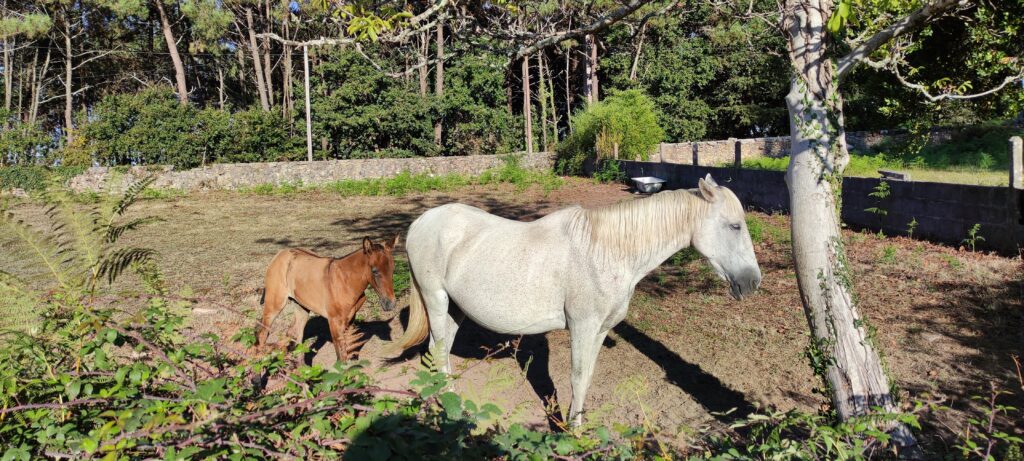
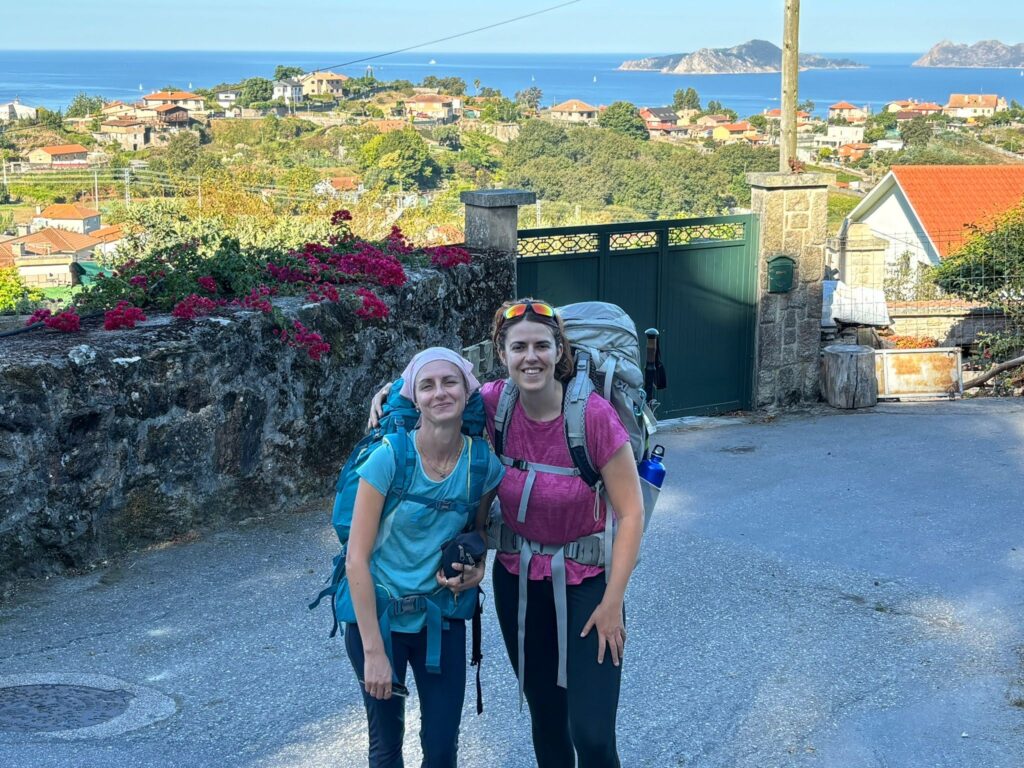
We communicated in a mixture of Spanish, Italian and English. I didn’t even have to think, I expressed my thoughts in the language that came up first in my head.
I loved mixing languages, I loved our deep discussions about politics and tolerance in the world. She currently worked in a bank, but she was thinking of becoming a nurse. The idea of doing something good for the world made quite an impact on me.
Funny, we actually met in the Buen Caminha albergue at the communal dinner, but we didn’t have a chance to talk. I very much enjoyed walking alongside this funny woman. According to her, she was given a tiny bladder, so she peed very often. We made a longer detour to a bakery, hoping to find a nice place to pee, because it was not easy to find a natural hiding spot on the route. They didn’t let us use their toilet, but Chiara at least bought lunch – a Galician empanada de atún. It looked like a solid chunk of food that she named “pietra di tonno (tuna stone)”.
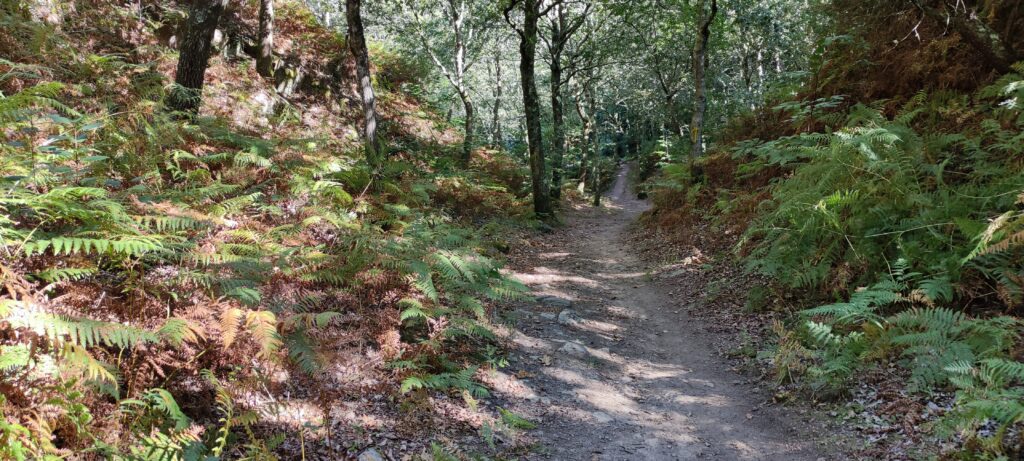
The Camino led us into beautiful forests giving a pleasant shade. Chiara entertained me with stories about her rescue dog until we reached the outskirts of Vigo. The rest of the walk passed through the industrial area. We were not happy walking through, of course, but I like the fact that the Camino has ugly parts too. We split in Vigo and shared a warm hug. She would continue walking tomorrow; I would take a day off.
Maria was busy choosing her new shoes in a Corte Inglés mall. Since I arrived early in the afternoon, I checked into the hotel and thought about exploring the town and getting more passport stamps. I ended up on the main shopping street on a Saturday, where I could last for around ten minutes. The hustle and bustle of people, live music and cars felt overwhelming and confusing. I retracted to a side street where I licked my ice cream and took many deep breaths. Then I went to smell books in a bookstore to calm down. This pilgrim came from a peaceful jungle to the city and couldn’t wait to return.
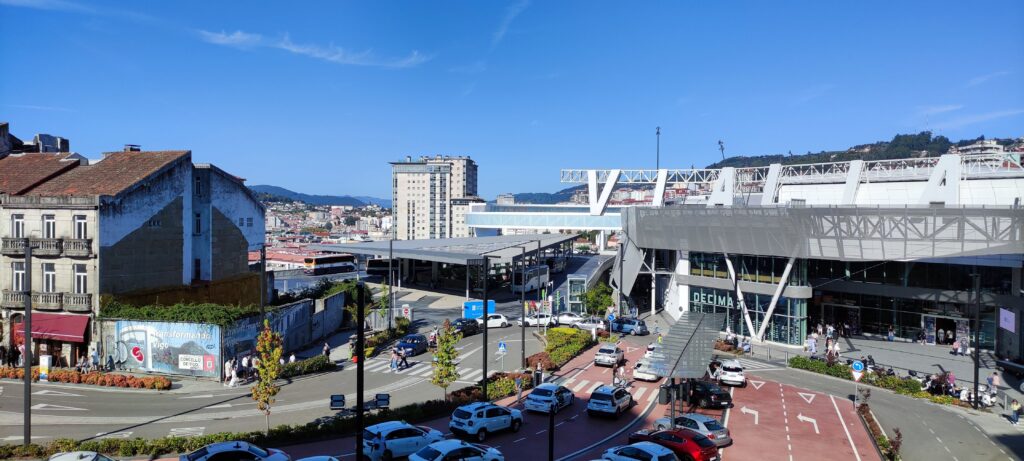
Maria needed help with the shoes and she was exhausted after hours of trying almost every model in the store. She picked Brooks road running shoes in the end, but still wasn’t sure about the size. I took her out for ramen, reminding her of her Japanese future. I offered to book an albergue for both of us in Redondela, on the next Camino stage. We could still share a part of the journey together, because the Spiritual Camino only starts two days after Vigo. She wanted to book something herself later, so I booked a spot just for myself. When she returned to the hotel, there were no albergues available anymore. Maria was pissed and I didn’t feel good about the situation either. Moreover, I had no accommodation on the first day of my Spiritual path, which made me worried. There was nothing available that I could book. I planned to sleep in the municipal albergue, hoping that it would have a bed for me when I arrive.
Sometimes in life you need to have faith that things work out, and I am terrible at this. Spoiler alert: I’m good at connecting with people. I asked for help.
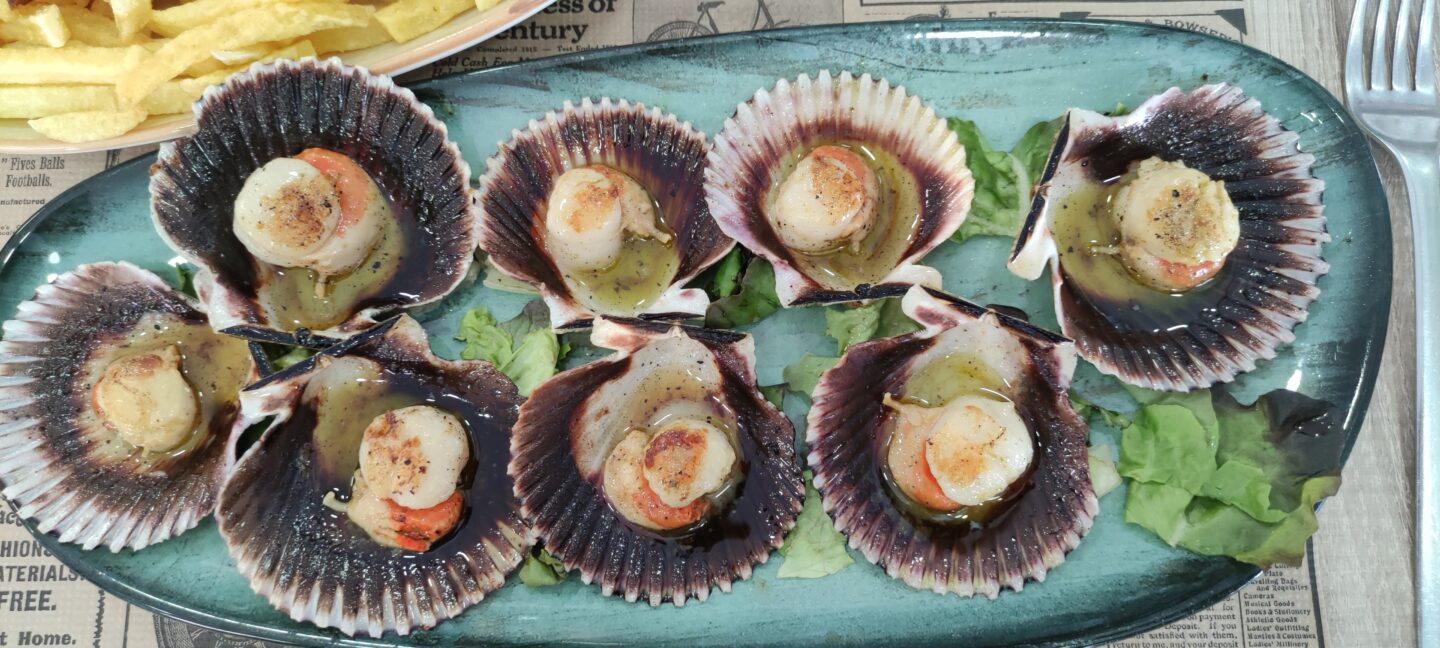
Leave a Reply